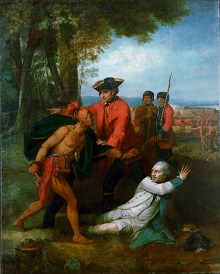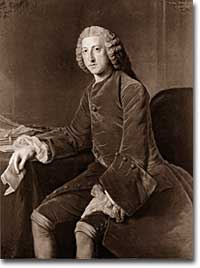8b. The French and Indian War

General Johnson Saving a Wounded French Officer from the Tomahawk of a North American Indian
Benjamin West, ca 1766
Round four of the global struggle between England and France began in 1754. Unlike the three previous conflicts, this war began in America. French and British soldiers butted heads with each other over control of the Ohio Valley. At stake were the lucrative fur trade and access to the all-important Mississippi River, the lifeline of the frontier to the west. A squadron of soldiers led by a brash, unknown, twenty-two year old George Washington attacked a French stronghold named Fort Duquesne. Soon after the attack, Washington's troops were forced to surrender. Shortly after that, a second British force also met with defeat. When news of this reached London, war was declared, and the conflict known in Europe as the Seven Years War began. Americans would call this bout the French and Indian War.
The first phase of this war was a sheer disaster for Britain. Assaults on French territory ended in bitter defeat. The French and their Indian allies inspired fear on the British frontier by burning and pillaging settlements. The French struck within sixty miles of Philadelphia. Americans were disheartened. They believed that Britain was not making the proper commitment to North America.

British Secretary of State William Pitt helped turn the tide against the French. He is also the namesake of Pittsburgh, Pennsylvania.
The turning point in the war came when William Pitt took over the wartime operations. He believed North America was critical for England's global domination. Pitt turned recruitment and supplies over to local authorities in America and promised to reimburse them for their efforts. He committed more troops and juggled the command, replacing old war heroes with vigorous young ones.
Militarily, the tide began to turn, as the British captured Louisbourg, an important strategic port the British used to close the St. Lawrence Seaway. The death blow to the French cause was struck in Quebec in 1759. Commander James Wolfe bravely sent his forces up a rocky embankment to surprise the French. The battle that followed on the Plains of Abraham killed Wolfe and the French commander, as the crucial stronghold was transferred to British hands. It would only be a matter of time before Montreal suffered the same fate.
The French chapter of North American history had ended in a bloody finale.






